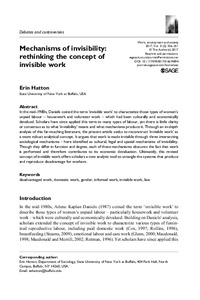Mechanisms of invisibility: rethinking the concept of invisible work

2017
31
2
April
336-351
domestic work ; gender ; law ; informal employment
Employment
http://dx.doi.org/10.1177/0950017016674894
English
Bibliogr.
"In the mid-1980s, Daniels coined the term ‘invisible work' to characterize those types of women's unpaid labour – housework and volunteer work – which had been culturally and economically devalued. Scholars have since applied this term to many types of labour, yet there is little clarity or consensus as to what ‘invisibility' means and what mechanisms produce it. Through an in-depth analysis of this far-reaching literature, the present article seeks to reconstruct ‘invisible work' as a more robust analytical concept. It argues that work is made invisible through three intersecting sociological mechanisms – here identified as cultural, legal and spatial mechanisms of invisibility. Though they differ in function and degree, each of these mechanisms obscures the fact that work is performed and therefore contributes to its economic devaluation. Ultimately, this revised concept of invisible work offers scholars a new analytic tool to untangle the systems that produce and reproduce disadvantage for workers."
Digital
The ETUI is co-funded by the European Union. Views and opinions expressed are however those of the author(s) only and do not necessarily reflect those of the European Union or the ETUI.